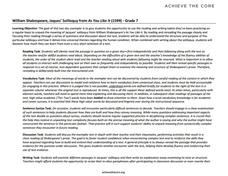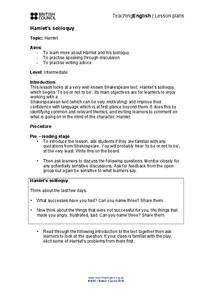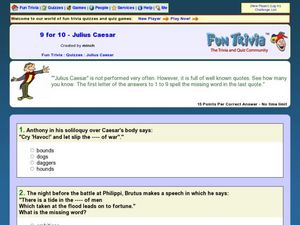Curated OER
"As You Like It" by William Shakespeare
Jacque's soliloquy from Act II, scene ii of As You Like It sets the stage for a close reading exercise that models how to approach difficult, dense text and enables readers to practice reading comprehension and analysis...
Curated OER
Rewriting Shakespeare
Have your learners play around with Shakespeare's language. In this plan, small groups examine and rearrange soliloquies from Othello, noting how the language changes and morphs. All groups have a chance to change each soliloquy, making...
Utah Education Network (UEN)
Hamlet Soliloquy Artwork
Though this assignment may be thought madness, there is an actual method. Scholars perform a close reading of the original text of the soliloquies in Hamlet and modern translations to ensure they understand the speeches. They then select...
Curated OER
Hamlet's Soliloquy
Everyone is familiar with the beginning of Hamlet's soliloquy, "To be or not to be..." While reading Hamlet, help your middle schoolers analyze the lines that follow, but how do you help them make personal connections to the text? Use...
Curated OER
Unlocking Soliloquies and Unleashing "the Dogs of War"
What is a soliloquy, and who is Julius Caesar? Explore soliloquies with this lesson plan that gets your kids up and moving! Learners line up, facing each other. Then they read the soliloquy (one side reads one line, and the other side...
Curated OER
Illuminating Our Human Experiences: Soliloquy from Hamlet
Students determine the meaning of a soliloquy and examine the themes in Shakespeare's, Hamlet. In this literature lesson, students read Hamlet's soliloquy and watch a Photo Story 3 text model of such. They write a personal soliloquy...
Curated OER
Hamlet's Soliloquy
In this literature learning exercise, students use Hamlet's soliloquy for a series of activities. Students match quotes with modern interpretations. Students reflect on and relate to Hamlet's feelings. They also give advice to Hamlet.
Curated OER
Richard III by William Shakespeare
In this literature activity, students respond to 25 short answer and essay questions about Shakespeare's Richard III. Students may also link to an online interactive quiz on the selection at the bottom of the page.
Penguin Books
A Teacher's Guide to William Shakespeare's Hamlet
Should Hamlet avenge his father's death? Is the ghost telling the truth or is it trying to trick Hamlet? Is Hamlet's inconsistent behavior a ploy or is he really insane? Something really is rotten in Denmark, and with the help of the...
K12 Reader
Mark Antony’s Oration from Julius Caesar
"And Brutus is an honourable man." Or is he? Readers of Shakespeare’s tragic Julius Caesar are asked to identify the rhetorical devices Mark Antony uses in his funeral oration and to explain how these devices influence the...
Curated OER
Shakespeare: Hamlet's Soliloquy
Twelfth graders use the Internet to find Prince Charles' version of the Hamlet soliloquy, read and discuss Hamlet's To be or not to be soliloquy and, using the study guide questions, read and discuss Prince Charles' update of the soliloquy.
Curated OER
Appreciating the Language and Interpreting the Meaning of Hamlet's Soliloquy
Students analyze Hamlet's soliloquy, "To be or not to be." In this Hamlet lesson, students define unfamiliar words in the soliloquy and interpret the lines. Students then read the lines aloud and identify descriptive words....
Curated OER
"I am determined to prove a villain" Richard III, Shakespeare, and the Creation of Villains
Learners create a list of historical and fictional figures to identify their villainous behaviors and qualities. In this Shakespeare lesson, students discuss historical and fictional villains and their common characteristics. Learners...
Curated OER
Emulating Shakespeare: To Snooze or Not To Snooze
Young scholars reproduce the pattern of one of Shakespeare's soliloquies, but use their own ideas and words to replace the character's. They replace each word with a word of their own that serves the same purpose.They discuss the speaker...
Curated OER
Hamlet 1.2: Hamlet's First Soilloquy
O, that these too, too obscure words would resolve themselves into modern English! High school scholars are asked to do a close reading of Hamlet’s first soliloquy (I, ii) and recast these famous lines into contemporary speech, identify...
Curated OER
A Midsummer Night's Dream Acts 1-2
Blank verse, stichomythia, soliloquy, allusion, oxymoron, malaprop? Readers of A Midsummer Night’s Dream will need to know these terms to successfully complete a study guide designed for the first two acts of Shakespeare’s comedy. The...
Curated OER
9 for 10 - Julius Caesar
Choose the missing word in several quotes from William Shakespeare's The Tragedy of Julius Caesar. Most are multiple-choice, though a few are fill-in-the-blank. The last answer is made from the first letters of the previous answers.
EngageNY
Grade 9 ELA Module 1: Unit 3, Lesson 11
The study of Romeo and Juliet continues as pairs use the provided summary tool worksheet to record evidence of how Shakespeare uses dramatic irony to heighten the tension in Juliet's soliloquy in Act 3, scene 2, lines 1–31.
EngageNY
Grade 11 ELA Module 1: Unit 2, Lesson 11
What is Hamlet's attitude towards life and death in Shakespeare's Hamlet? Scholars continue reading the play to answer the question, paying particular attention to Hamlet's most famous soliloquy. By holding a discussion and completing...
EngageNY
Grade 10 ELA Module 4: Unit 2, Lesson 9
How does Shakespeare develop the central idea of agency versus fate in Macbeth? Using the resource, pupils work in small groups to discuss the plot of Act 3.1. Next, they complete a brief writing assignment to analyze how the main idea...
EngageNY
Grade 10 ELA Module 4: Unit 2, Lesson 10
Is it better to be dead than to "dwell in doubtful joy," as Lady Macbeth suggests in Act 3.2 of Shakespeare's Macbeth? Using the resource, scholars work in small groups to discuss how Lady Macbeth and Macbeth begin to unravel following...
EngageNY
Grade 11 ELA Module 1: Unit 2, Lesson 18
How does the comparison of Hamlet to Fortinbras develop Hamlet's character? Scholars complete a Quick Write to answer the question. They also continue their exploration of Shakespeare's Hamlet, reading and discussing Act 4.4.
EngageNY
Grade 11 ELA Module 1: Unit 2, Lesson 8
How does Shakespeare employ figurative language to emphasize central ideas in Hamlet? Using an interesting resource, learners complete a Quick Write to answer the question. Additionally, they continue their study of the play by exploring...
Curated OER
Much Ado About Something (Lesson 6)
View a video clip about Shakespeare's work. Identify the ambiguities in his texts. Practice reading well-known soliloquies.

























